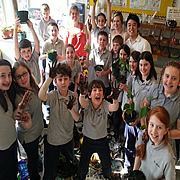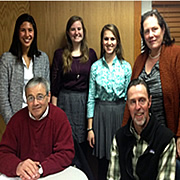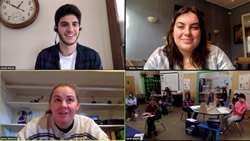By Theme:Arts and Literature | Campus Sustainability | Community Perspectives | Development | Economic Analysis | Ecosystem Analysis | Education | Energy | Environmental Justice | Food Systems | Geology of the Watershed | Green Architecture | Green Business | History of the Watershed | Invasive Species | Land Use Patterns | Public Policy | Recreation | Transportation | Water Quality
Education
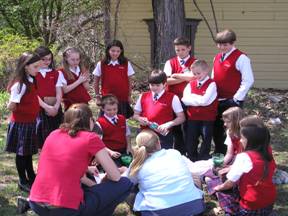 A Watershed Education Guide for Saratoga Lake
A Watershed Education Guide for Saratoga Lake
Lauren Fletcher and Sieglinde Mueller (2008)
The Saratoga Lake Watershed Education guide was created through an analysis of existing environmental education curricula and tailoring the activities to 3rd, 4th, and 5th grade students within the local watershed. The project culminated in a 32-activity education guide that incorporates indoor and outdoor activities and focuses on hands-on learning. The activities were field tested at two local elementary schools: Saratoga Independent School in Saratoga Springs, NY, and Saint Mary’s School in Ballston Spa, NY.
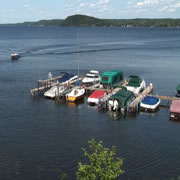 The Saratoga Lake Watershed: Connecting Biodiversity and Community
The Saratoga Lake Watershed: Connecting Biodiversity and Community
Jonathan Betz ’09 and Chris Grassi, Visiting Assistant Professor of Anthropology (2008)
The proximity and local debates over the uses of Saratoga Lake and its watershed provide an opportunity to educate both the Skidmore and local community about the connections between water, local wildlife, people, and land use. Therefore we are producing an educational film about the physical, biological, and social aspects of this watershed. We have conducted 17 formal interviews and recorded over 30 hours of film. These will be used to represent the ways in which people interact with the watershed and the interests of these different stakeholders. We have identified themes within these perspectives that demonstrate links and conflicts in viewpoints.
 Designing and Institutionalizing a Place-Based Watershed Curriculum in Ballston Spa
Designing and Institutionalizing a Place-Based Watershed Curriculum in Ballston Spa
Hannah Phillips and Sarah Whateley (2009)
We designed place-based lesson plans to complement the in-class ecosystem unit for a fifth grade classroom in Ballston Spa, New York and to increase students’ awareness of place. Our interviews with local teachers and administrators identified challenges to implementing such programs. We also assessed the students’ prior environmental knowledge.
Full report is not available. Please contact Bob Turner for more information.
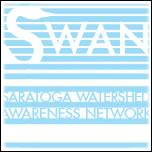 SWAN: An Online Education Guide for the Saratoga Lake Watershed
SWAN: An Online Education Guide for the Saratoga Lake Watershed
Mel Ausanka-Crues and Stephanie McGurk (2010)
The Saratoga Watershed Awareness Network (SWAN) is a new online education guide to inform local stakeholders about the threats to the Saratoga Lake Watershed. The website is a synthesis of past Skidmore capstone research and will continue to be updated with future studies. Current pages include information concerning development and impervious surfaces, water shortages, and septic systems.
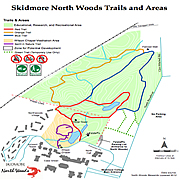 No Child Left Indoors: An Analysis of Local Place-based Elementary Environmental Education
No Child Left Indoors: An Analysis of Local Place-based Elementary Environmental Education
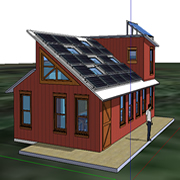 Designing a Sustainable Field Research Station for Skidmore College’s Off Campus Properties
Designing a Sustainable Field Research Station for Skidmore College’s Off Campus Properties
Marcus Goldbas, Gwyn Harris, and Lily Alverson (2013)
We developed an architectural design for a field station that will increase the use of Skidmore’s forested properties for teaching, learning, and outdoor activities, while implementing sustainable design strategies to limit the environmental impacts on the surrounding landscape. We combined stakeholder analyses with evaluations of siting, orientation, climate, access/transportation, solar energy, passive solar heating, storm water management, rainwater catchment, day lighting, and materials, and offer a proposal to the Skidmore Community.
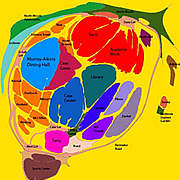 Conceptual Landscapes on Skidmore Campus: Reconciling Perception and Reality
Conceptual Landscapes on Skidmore Campus: Reconciling Perception and Reality
Hannah Greendorfer, Meghan Burke, and Abby Wyant (2013)
Colleges are constantly adapting to internal and external pressures. In the past ten years Skidmore College has increased in size and scope. Our project aims to illustrate how the Skidmore population views and interacts with the college campus. We investigate the conceptualizations of space using cognitive maps drawn by members of the Skidmore community. The assessment of space can then influence future developments and supports sustainable design and a strong Skidmore community.
Haley Duncan, Anna-Beth Lawler, and Duke Yun (2013)
Today, children face depravation from nature, unhealthy eating habits, and limited physical activity. Garden-based learning can address all of these issues, while also enhancing science classes. We developed a 5-week indoor, garden-based, after-school program with fourth and fifth graders from St. Mary's elementary school in Ballston Spa to measure their effectiveness. Successful gardening programs must create allies within the school and ultimately influence in-classroom curriculums.
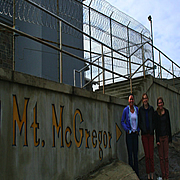 Breaking In: Educating Prisoners Through Environmental Literacy
Breaking In: Educating Prisoners Through Environmental Literacy
Sondra Lipshutz, Kristen Stearns, and Sarah LaBella (2013)
How can the impact of the environmental movement reach underserved communities? Our project involved seeking nontraditional allies in prisoners, working with Mt. McGregor Correctional Facility in Wilton, NY to implement an environmental literacy program for inmates. Literature, film, and interactive activities introduced inmates to topics from climate change to green jobs. We used pre- and post-surveys to evaluate the program and made suggestions for future Skidmore/prison collaboration in the field of environmental studies.
Jennifer Garvin, Faith Nicholas, and Lauren Schilling (2014)
We examined the current household hazardous waste (HHW) program of Saratoga Springs in the hopes of enhancing participation and expansion. We researched other municipal HHW programs in New York State and surveyed Saratoga Springs residents. Our study led us to the following recommendations: utilize permanent facilities within the community, hold collection days multiple times a year, and provide substantial educational material.
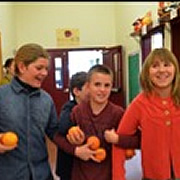 Cultivating Seeds of Change: Knowledge, Perception and Behavior Outcomes of an Experiential
Plant Literacy Curriculum
Cultivating Seeds of Change: Knowledge, Perception and Behavior Outcomes of an Experiential
Plant Literacy Curriculum
Lauren Mamuszka, Jenna Frank, and Eliza Hollister (2015)
We measured the environmental knowledge, perceptions, and behavioral outcomes of an experiential plant-literacy curriculum designed for 5th and 6th graders at an independent elementary school in Saratoga Springs, NY. This study reinforces existing literature and provides a better understanding of how experiential pedagogy and small-scale agricultural systems can be used as effective teaching tools. Treatment group students showed statistical improvement in environmental knowledge and behaviors at post-test.
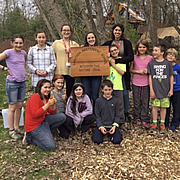 Environmental Education and Interpretive Trailblazing at Saratoga Independent School:
Environmental Education and Interpretive Trailblazing at Saratoga Independent School:
Katie Cuthbert, Emma Ottenheimer, & Kylie Rosabal (2016)
We worked at the Saratoga Independent School to develop an afterschool environmental club. We constructed an interpretive nature trail on school property that included stations, lessons, and activity suggestions for future use. Lessons focused on place-based education, nearby nature, and experiential learning. We conducted interviews and focus groups with students, teachers, and parents, and measured environmental knowledge, behavior, and attitudes with a control and treatment group.
Full report is not available. Please contact Karen Kellogg for more information.
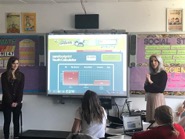 Climate change education with Catholic ideals: Measuring knowledge, attitudes and
behaviors
Climate change education with Catholic ideals: Measuring knowledge, attitudes and
behaviors
Meaghan Long and Bryn Sarner (2018)
We sought to bridge the gap between Catholicism and environmentalism. Three lessons were taught to a Catholic 5th grade class: environmental worldviews, the science of climate change, and environmental advocacy. We found a significant increase in knowledge while pro-environmental attitudes only slightly improved. Certain concepts were too advanced for 5th Graders. Our research is useful for better understanding environmental education that works to incorporate Catholic ideals.
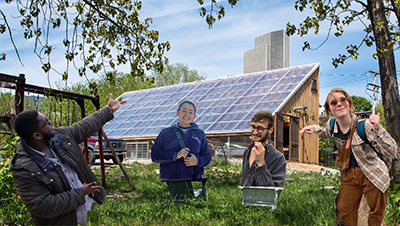 Impact & Outcomes of Environmental Education on Albany High School Students & Community
Perceptions of the Radix Ecological Sustainability Center
Impact & Outcomes of Environmental Education on Albany High School Students & Community
Perceptions of the Radix Ecological Sustainability Center
Isabel Beard, Audrey Erickson, Andy Rhodes, Brandon Wilson Radcliffe (2020)
We evaluated the impacts of an after-school program at the Radix Ecological Sustainability Center on Albany, NY high schoolers participating in environmental education (EE) programming, as well as the community perceptions of Radix’s youth programs. We addressed gaps in the literature by analyzing garden based, place-based, experiential, and transformative education and environmental justice, through EE at Radix. We found positive changes in environmental understanding and life-projections for students involved in Radix programming.
Paper is not available. For information, please contact the ESS Program Director.
Jonah Amron, Parker Heuer & Jenny Norcross (2021)
Environmental Education (EE) is a form of teaching that aims to increase students' ecological literacy, which is a person's overall understanding of the biophysical environment and its associated problems. We investigated the efficacy of online EE during a global pandemic on pro-environmental knowledge, attitudes, and behavior changes of fifth grade students. Our research showed online EE enhanced pro-environmental attitudes and behaviors as well as awareness surrounding environmental issues. Experiential learning, involving hands-on, activity-based lessons, were the most effective tools for teaching online ecological literacy.
